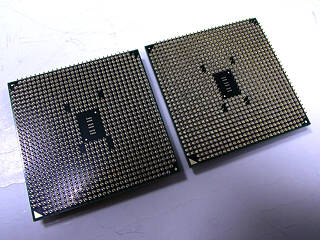 76
76
AMD Trinity FM2 APU Preview Review
APU Features »APU Design
There are quite a few changes here in the APU line-up, including the use of AMD's new x86 architecture featuring “Piledriver” cores. These cores have a few features of their own compared to previously released Bulldozer cores found on current AMD FX desktop chips. I've listed the new features below:
- Supports up to 4 cores and has support for the latest ISA instructions, including FMA4/3, AVX, AES, and XOP
- Branch Prediction and Cache enhancements over the previous “Bulldozer” cores
- 2MB L2 cache per dual-core module (up to a total of 4MB)
- Max Turbo Frequencies up to 4.2GHz
- Configurable via AMD OverDrive

The GPU portion of AMD's APUs has seen a slight update as well, and again, the details are listed below.
- Featuring VLIW 4 architecture
- Up to 384 shaders
- Up to 800MHz
- Up to 8xAA and 16AF support
- DirectX 11 Support
- Controllable via AMD OverDrive
With all of those changes, the pin layout for these new AMD FM2 APUs has changed slightly as well, as illustrated in the picture above. That picture has the new FM2 APU on the left and the older FM1 APU on the right. There's actually one less pin in use with the new APUs. One of the other places that had a pair of missing pins on the older FM1 APUs has been moved over slightly as well. As I mentioned earlier, AMD had to update the AM3 socket to get full support for Bulldozer-based FX chips. AMD named their upgraded variant AM3+ and explained that their design change was necessary due to changes in power delivery. It only makes sense that the same changes were needed when introducing Piledriver to the APU design, since the older APUs had a different CPU core design that resembled older Socket AM3 CPU cores. It's interesting to note that PCIe 3.0 has not been adopted here, and I am not sure when AMD will be offering PCIe 3.0 with their CPU products, but it does seems a bit out of place not to have PCIe 3.0 because the socket is changing anyways.
Mar 10th, 2025 13:10 EDT
change timezone
Latest GPU Drivers
New Forum Posts
- Gaming PC instabiliity (16)
- Zen6 is almost here ? (44)
- It's happening again, melting 12v high pwr connectors (1019)
- RX 9070 availability (162)
- newegg ATX 3.1 PSU on Clearance and Free Fan (2)
- What's your latest tech purchase? (23269)
- Samsung 9100 PRO is on preorder (0)
- I'm looking for a good tool to make the 3D scanning of my mini-pc using the photogrammetry and my Kinect 2. (45)
- 2022-X58/1366 PIN Motherboards NVME M.2 SSD BIOS MOD Collection (903)
- Surface laptop 5 TPL Speed Shift ignored? (1)
Popular Reviews
- Sapphire Radeon RX 9070 XT Nitro+ Review - Beating NVIDIA
- XFX Radeon RX 9070 XT Mercury OC Magnetic Air Review
- ASUS Radeon RX 9070 TUF OC Review
- MSI MAG B850 Tomahawk Max Wi-Fi Review
- NVIDIA GeForce RTX 5080 Founders Edition Review
- NVIDIA GeForce RTX 5070 Founders Edition Review
- Corsair Vengeance RGB CUDIMM DDR5-8800 48 GB CL42 Review
- AMD Ryzen 7 9800X3D Review - The Best Gaming Processor
- ASUS GeForce RTX 5070 Ti TUF OC Review
- MSI GeForce RTX 5070 Ti Gaming Trio OC+ Review
Controversial News Posts
- NVIDIA GeForce RTX 50 Cards Spotted with Missing ROPs, NVIDIA Confirms the Issue, Multiple Vendors Affected (513)
- AMD Plans Aggressive Price Competition with Radeon RX 9000 Series (277)
- AMD Radeon RX 9070 and 9070 XT Listed On Amazon - One Buyer Snags a Unit (261)
- AMD RDNA 4 and Radeon RX 9070 Series Unveiled: $549 & $599 (260)
- AMD Mentions Sub-$700 Pricing for Radeon RX 9070 GPU Series, Looks Like NV Minus $50 Again (248)
- NVIDIA Investigates GeForce RTX 50 Series "Blackwell" Black Screen and BSOD Issues (244)
- AMD Radeon RX 9070 and 9070 XT Official Performance Metrics Leaked, +42% 4K Performance Over Radeon RX 7900 GRE (195)
- AMD Radeon RX 9070-series Pricing Leaks Courtesy of MicroCenter (158)

